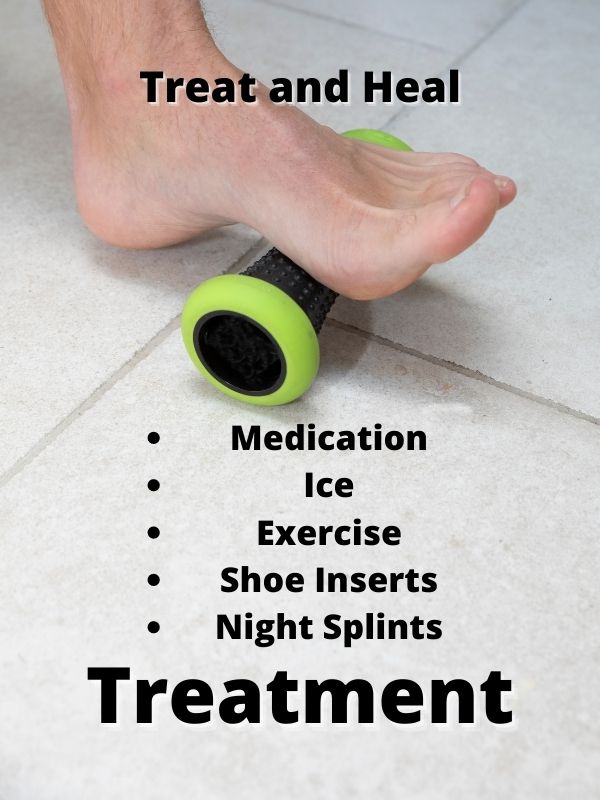Plantar fasciitis is the inflammation of the the tissue that connects your heel to your toes. It can manifest as a sharp stabbing pain in your heel and arch. If you are a runner, wear worn out shoes, have flat feet, or are obese, you are at a higher risk of developing plantar fasciitis.
Some of the symptoms of fasciitis include sharp heel pain, increasing pain over a period of time, pain after rest, swelling, burning.
Many treatment options exist to cure plantar fasciitis. Some of these include: taking medication, applying ice, doing stretching exercises, adding shoe inserts, and using night splints.
The treatment of plantar fasciitis can take approximately 6-12 months. The connective facia tissues need to heal. Keeping in mind an individual’s age, lifestyle, and other factors, plantar fasciitis can be treated successfully. Most of the treatment options can be practiced at home, however, in some cases, you may need to see a doctor.
What is Plantar Fasciitis?

The plantar fascia is a thick ligament that that absorbs impacts as you walk or run. If this part of the foot experiences any trauma, it can result in tears in the fascia. Prolonged stress and tears can cause inflammation and pain.
Those who run, walk, and exercise may put excessive force on their plantar fascia tendon. Tearing can occur with too much force. If you are over 40, are over weight, and are on your feet a lot, these factors may contribute to tears in your tendon.
5 Symptoms of Plantar Fasciitis

People who experience plantar fasciitis complain of sharp stabbing pain at the bottom of their foot, near the heel. The pain is particularly strongest in the morning during the first few steps.
The pain can be worse through prolonged standing or sitting up after standing. It can also be triggered after exercising. Here are some of the symptoms of plantar fasciitis that most adults experience.
1. Sharp heel pain
If you experience sharp pain at the bottom of your heel, right behind the arch of your foot, it can very likely be due to plantar fasciitis.
2. Increasing pain over a period of time
When you have plantar fasciitis, the pain increases over a period of time. If you notice an increasing pain every month, it can be a sign of plantar fasciitis.
3. Pain after rest
When you wake up in the morning and notice sharp pain within the first few steps, that is a sure sign of plantar fasciitis. Also if you have been sitting for a long time, and then start walking, it can also trigger the pain.
4. Swelling
Plantar fasciitis results in the bottom of your heel getting swollen and tender.
5. Foot burning
Some people have experienced a burning sensation at the bottom of their foot. This could be due to irritation to a nerve due to the pressure of walking.
When to See a Doctor

If you’ve already determined what the problem is and your getting better, you may not need to see a doctor.
Most of the time, with the right treatment, plantar fasciitis may improve over time. However, if you experience worsening symptoms or are not sure about the problem, visit your doctor.
You can also see a doctor at the beginning of your treatment so they can provide a targeted treatment plan for a speedy recovery.
Most remedies will help cure your symptoms, however, if things don’t settle down in a few months, your doctor may recommend physical therapy. In rare cases, you may require surgery.
5 Treatments for Plantar Fasciitis

You can try many home remedies to treat your plantar fasciitis. However, if you feel the pain isn’t subsiding, it is a good idea to go see a doctor. Your doctor will recommend some therapies to help speed up the recovery process. Here we have listed some of the ways to treat plantar fasciitis.
1. Medication
Pain-relieving medication such as nonsteroidal anti-inflammatory drugs (NSAIDs) can ease your pain. Medications like ibuprofen or naproxen sodium help reduce inflammation of the plantar fascia. Your doctor may recommend dosage for several weeks to a few months.
Some people use turmeric (Amazon.com) or other supplements to help with inflammation. I know some people who take medicine without any problems, and others who find relief with supplements because they prefer a more natural approach.
2. Ice the area
Cold therapy shrinks the blood vessels and reduces the blood flow to the inflamed area. Applying ice to the affected area can reduce inflammation and swelling of your foot. Here are a few ways to ice your plantar fasciitis.
Fill a bottle with tap water (leave 25% empty). Freeze the bottle overnight. Lay a towel on the floor and place the bottle on the side of the towel. Now sit on the chair and place your foot on the bottle. Slowly roll your foot over the bottle, applying gentle pressure to the plantar fasciitis. Occasionally lift your heel so your inner sole is stretched. Point your toes downwards to stretch the top of your foot. Do this exercise for 15 minutes daily, several times a day. Avoid going over 20 minutes.
You can also try the traditional ice pack approach. Take an ice pack or fill a plastic bag with crushed ice. Apply it on your heel 3-4 times a day for 15 minutes.
3. Exercise
The reason you experience pain when you walk after waking up from sleep is that when your feet are at rest, the plantar fascia shortens. This can tighten your fascia which can result in severe pain. Exercise helps the blood circulate through your feet and prevent the fascia from contracting.
If medication and ice don’t help, you can try a few exercises. Some exercises can help stretch your fascia to provide stability to your ankle and heel. This will help strengthen your leg muscles and help in a faster healing process.
Exercising your lower leg and foot muscles can help ease the pain. Try stretching your calves, Achilles tendon, and plantar fascia.
Before getting out of bed, stretch and massage your feet to reduce heel pain. Flex your foot up and down 10 times. You can also stretch your toes to help stretch the plantar fascia as well.
4. Shoe Inserts
Shoe inserts provide cushion and added support to your feet. They reduce pressure and support the arch of your feet.
Insoles or inserts (Amazon.com) are usually available over-the-counter. Try to practice walking with them and see if you notice any difference. Alternatively, you can also ask your doctor to prescribe a custom-made insole for you.
When choosing an insole, make sure to invest in a firm and thick one for extra cushioning. Good shoe inserts help redistribute the pressure on your feet and provide extra support for your arch and heel. Insoles also help stabilize the plantar fascia and prevent it from worsening any further.
5. Night Splints
Night splints (Amazon.com) are heel braces that keep your foot at a 90-degree angle while you sleep. This helps provide a gentle stretch to the plantar fascia and Achilles tendon.
If your feeling pain in the morning, these could help you find the relief you want. They aren’t for everyone because they aren’t easy to sleep with. Those who have consistent pain may feel these are helpful for pain relief even if it is uncomfortable for a while.
Conclusion
If you are having any of the symptoms of plantar fasciitis, then you can start to take action to help prevent it from getting worse and start the healing process. See your doctor if you experience worsening symptoms.
The list of treatments above are some of the common way to help deal with plantar fasciitis. Make sure your feet get enough rest and wear a good pair of comfortable shoes to avoid any further inflammation. If you have foot pain, it may be best to consult your doctor first to be sure about what’s going on and then start working on treatments.
Thanks for Visiting Helpshoe.com

